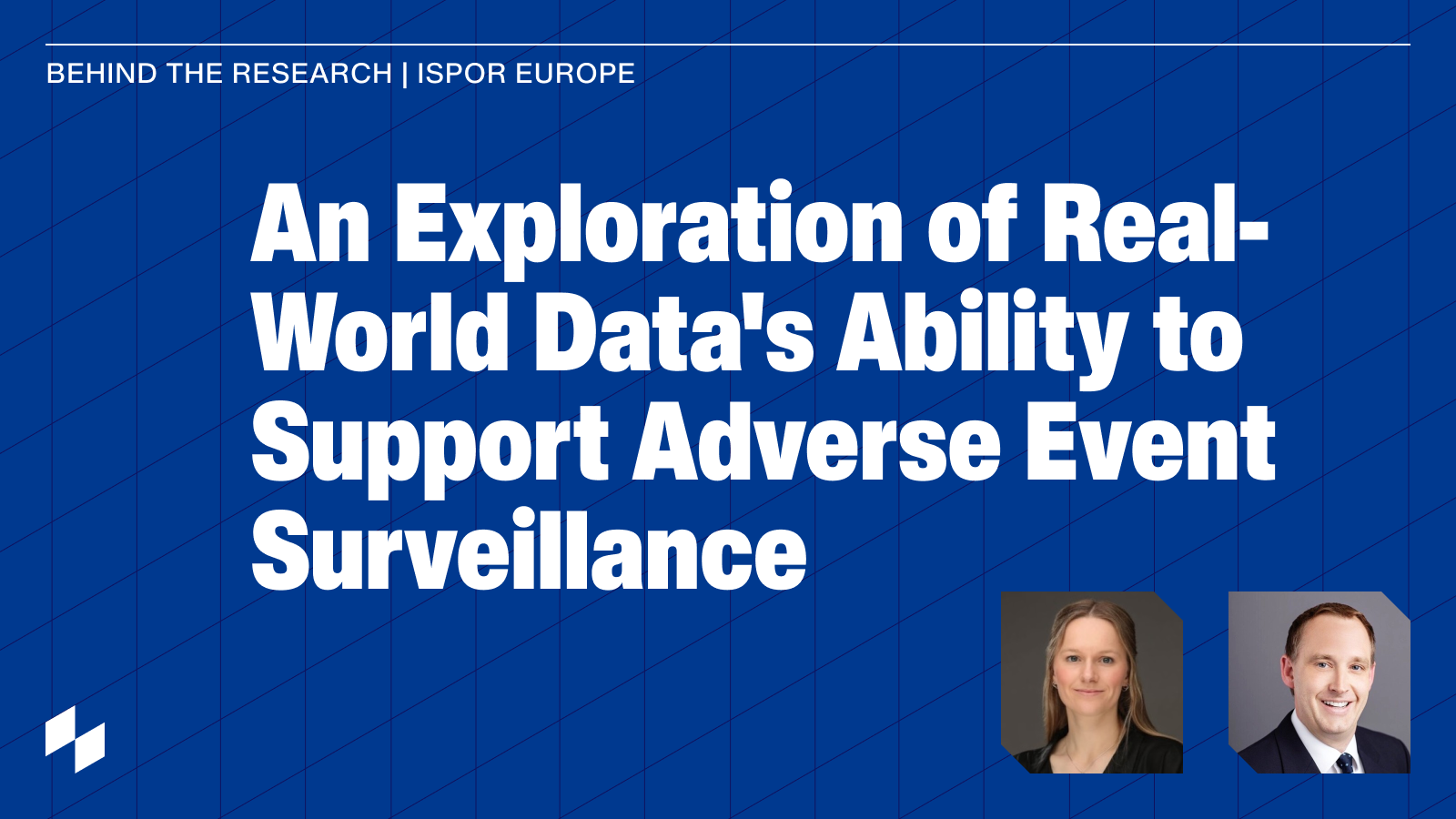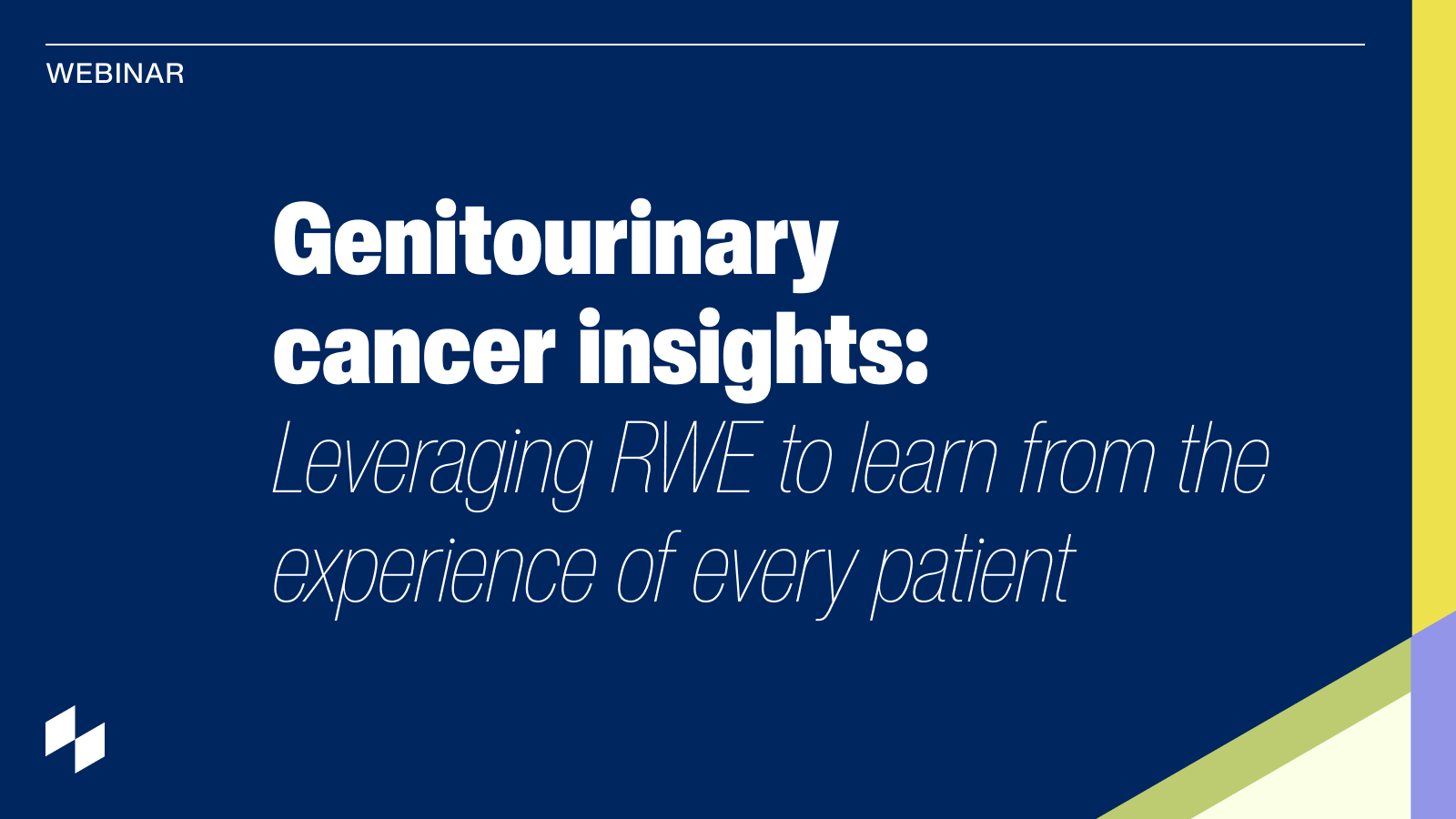Thibaut Sanglier, PharmD, MPH, PhD and his team from Roche leveraged EHR-derived real-world evidence to secure a label update. See how in this case study.
This talk is part of the ResearchX session: Applying RWE to Regulatory Applications.
Sections include:
- Integrating Clinical & Genomics Real World Data to Support New Drug Application
- Postmarket Real World Data Perspectives: IBRANCE (palbociclib) Males Case
- Kadcyla (T-DM1) in HER2+ mBC Label Update on LVEF following a post approval commitment – based on RWD
- Getting Real: Real World Evidence in Oncology Drug Approvals
Transcript
Thibaut Sanglier: Thank you very much, Jillian. Good morning, good afternoon, good evening, everyone. So, I think we can move to the disclaimer page. I'm a full-time employee of Roche. Next slide, please. This presentation shares my view and not necessarily those of Hoffman-La Roche. Next slide, please.
For the next 10 minutes, I will share with you an example of how we used real-world data to address European commitment, and the fulfilling of this commitment led to an update of the core datasheet of Kadcyla and label updates in various countries. Throughout this the next 10 minutes, I will answer the three following questions: why real-world data? With a specific focus on why secondary data use was particularly relevant to us. What is the study about? The study I'm going to present, and what are the learnings we've drawn from this experience? Next slide, please.
In terms of clinical context and a bit of background, Kadcyla has different indications. One of them is in the metastatic setting where Kadcyla is indicated in patient previously treated with HER2 targeted therapies. In the clinical development program of Kadcyla, patient with a low left ventricular ejection fraction were excluded from the randomized clinical trial. So, patients with low LVEFs or LVEF lower than 50% were not included in the clinical trials. We had no cardiac safety data on the use of Kadcyla in patients with low LVEF after the approval.
Also, it's to be known that HER2 targeted therapies are also associated with an increased risk of developing left ventricular dysfunctions. So, two points that are important here. First, we're talking about the rare population. Low LVEF is quite rare in this population. And also, Roche committed to evaluate the cardiac safety outcome in patient initiating Kadcyla when they had a low left ventricular ejection fraction. Next slide, please. That is the timeline and regulatory context. Kadcyla was approved in the US in 2013, and in 2014 we had a category three commitment in the risk management plan of the company that aimed at addressing cardiac safety of the use of Kadcyla in this population. Next slide, please.
Initially, we proposed to evaluate the risk of interest in this population by using the metastatic breast cancer disease registries we were setting up at the time. When we made this proposal, we were very upfront with the health authorities, and we shared that we were under the impression that this population would be quite rare and that could be maybe a challenge in the recruitment of such a population. Next slide, please.
Actually, over the year when the registry started to recruit, we indeed started to face some challenges with respect to the recruitment, and that's why we started to inquire about using maybe different data that could help us to better document the risk of interest. That's why in 2016 we started to work with Flatiron, and we started to conduct a feasibility study in order to assess first the relevance of the data Flatiron had access to. But also, we wanted to assess the relevance of the technology that Flatiron could potentially use to answer our research question. Next slide, please.
Our intent was to use retrospective data, and from this retrospective data, identify a cohort of incident users. So, patients starting Kadcyla, and this user would have had to have an LVEF between 40 and 50%. Next slide, please. So, of course, we wanted to focus on baseline characteristic with a specific focus on cardiac condition and cardiac history. History of prior discontinuation to HER2 target therapy because of cardiac toxicity for instance.
Now, in terms of the outcome, we wanted to focus first on treatment-emergent adverse event, and we looked primarily at the incidence of an LVEF drop of more than 10% point from baseline, incidents of congestive heart failure, and other cardiac events. We also looked at symptoms and signs that were compatible with a clinical picture of CHF, of congestive heart failure, because we had some concern with maybe the risk of missing some outcome of interest. Next slide, please. Talking about the challenges and design consideration. We wanted to anticipate before designing the study, so the limitations here were potential limitation we considered before designing the study. First, we were aware that there was no background rate available because our population was really unknown at the time. We knew as well that there was a risk of protopathic bias meaning that patient who may start to experience early symptoms of the outcome could have been more likely to initiate Kadcyla.
And also, because we select a population conditional to the fact that they have some level of cardiac frailty, and we looked at cardiac outcome, we had to keep in mind that the outcomes we are measuring could be both actual new events, so incident cases, but also prevalent cases. And the rest of the slide talks more about limitation that are more general to the use of real-world data. So, in our case, in the context of safety, we wanted to define a risk period that was linked to the treatment duration, and treatment duration is not readily available in EHR, so we had to work with a range of sensitivity analyses on how to define this treatment duration.
We were also potentially in a situation of competing risk where the risk of death could compete with the risk of the cardiac events we wanted to measure. And also, then the other challenges that have also been raised in terms of misclassification, and the potential and the reporting of the outcome of interest, informative censoring, and missing data. Next slide, please.
So, what was really interesting for us at the time of the feasibility was the technology that the Flatiron team was suggesting to use. It was a technology... Next slide, please. The modular technology-enabled abstraction. For us, we knew the population was rare, and it was really interesting to work with Flatiron so they could query the structured data they have access to, to rapidly identify patient initiating Kadcyla for metastatic breast cancer. And then the team was able to use this modular technology-enabled abstraction to focus on the LVEF data of these Kadcyla patients. So, then it was possible to identify only the patient with the low LVEF, and then focus further abstraction on this patient. Next slide, please. On this slide we see the CONSORT chart of how we were able to identify our cohort of patient of interest. At the top of the chart, you see that we started with roughly 2,000 patients who started Kadcyla in the data set. Then the Flatiron used their modular abstraction to focus only on the LVEF data of these 2,000 patients. And then we had 135 patients who were potential candidates to be selected for analysis.
Now, applying other selection criteria we're able to identify 67 patient who had an LVEF in between 40 to 50% inclusive, and then we had a subset of those who were actually our primary cohort of patients with a left ventricular ejection fraction that was in between 40 to 49% and recorded within a two-month prior at the initiation of Kadcyla. One note here is that LVEF has many other lab values. It's sometimes reported as an absolute number, which is really helpful when you want to define a population according to a certain threshold. But also, sometimes it's reported as a range, so that's also why we had to work with the different types of cohorts.
On the next slide, we see just a snapshot of different results we had. Very briefly, on the top left corner, we see an estimation of the prevalence of different conditions we were interested in. What was really reassuring for us is that the prevalence of these conditions was actually quite in line with what we were expecting. On the right-hand side, you see the different outcomes and the different endpoint we use to look at the data and try to better quantify the cardiac risk in the safety population. So, we use different proportion, event rate, and the cumulative incidents at six months. Next slide, please.
In terms of the very high-level conclusions for this study. First, this study using Flatiron data, but also what we're seeing through the disease registry confirmed that the population of interest was actually quite rare. So, in very rare instances only Kadcyla was initiated in patients with low left ventricular ejection fraction. Most of the cases who presented, and one of the outcomes of interest during the follow-up actually presented with already a history of cardiac events or cardiac toxicity in the past before starting Kadcyla, and we did not observe a drastic increase of the cardiac risk in our study population.
For us, it speaks about the benefit-risk assessment that has to be done on a case-by-case basis in between the physician and the patients. And also, LVEF really has to be monitored throughout the course of HER2 treatments. Especially in this population. Next slide, please. Now, going back to the timelines and the outcome of this project. So, at the end of 2016. We were quite convinced that Flatiron was able to provide an added source of evidence that could be of relevance, and actually, this turned out to be the data we use in lieu of what was generated by the disease registries because the disease registry did not recruit enough patient at all. Next slide, please.
We proposed to the health authorities to go with Flatiron data to fulfill this proposal commitment and we registered the study on the ENCePP website before conducting the full analysis. We actually had the early interim analysis that was shared with the health authorities at the occasion of the PBRER. We had a publication of the result at the San Antonio Breast Cancer Symposium in 2019, and shortly after that, we received positive CHMP opinion in terms of the text we were submitting for the label.
This resulted in an update of the core datasheet for the compound and the update of the label of Kadcyla in Europe, in US, and Canada as well. The next slide. So, here is just an excerpt of the USPI with the study that is highlighted here in blue. Next slide, please. So, now going back to the beginning of this presentation. Why real-world data? First, it was about the research question that was really about routine clinical practice. And then why secondary data use? Because we intended initially to use prospective data, but in the end, it was so challenging to identify and recruit these patients that secondary data use was actually more fit for purpose approach.
This study was really about closing the gap on missing safety information in the population. It was not studied in clinical trials. And in terms of the learning for the team, and here it's really kudos to the regulatory team that did a fantastic job because it was possible for us to provide frequent update on the study status of both the registries and this study. It was also possible to share with health authorities and be very transparent with regard to the challenges we were experiencing.
Also, when these challenge were maybe too big, it was also possible to propose an alternate data source, so the Flatiron data. At the same time when we were making this proposal, it was possible for us to share the result of a feasibility. In the end, this study helped us to address European commitment that led to the update of the core datasheet of the product and change in the label of the product for Europe, US, and Canada, and the process is ongoing for other countries.
On the next slide, we have few references, and the next slide is an acknowledgment of the people who worked on this project over the years. Thank you very much.


